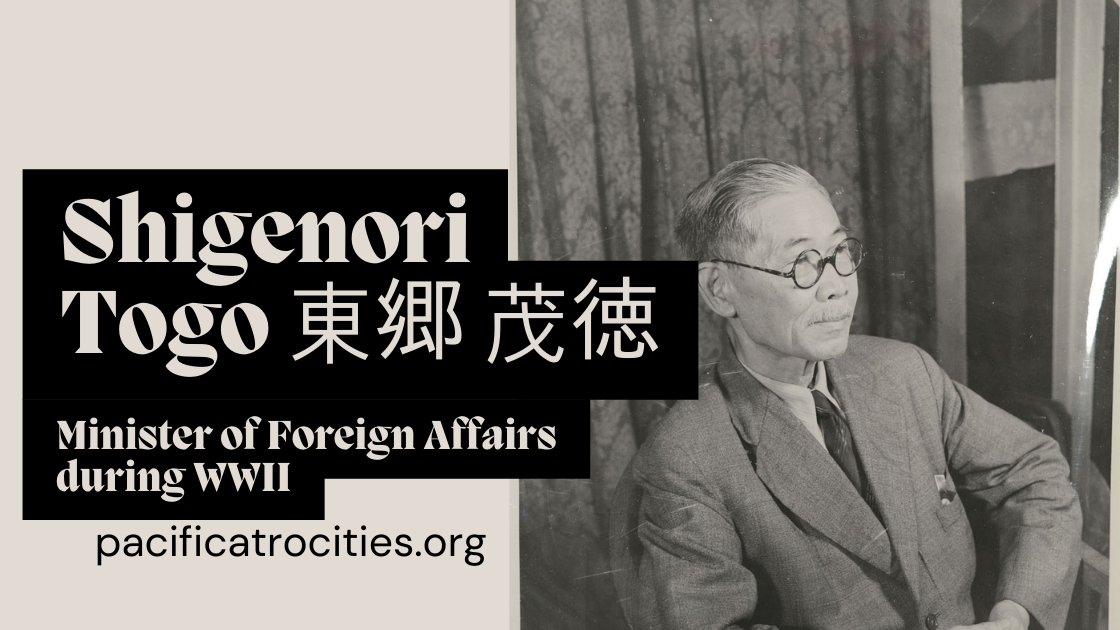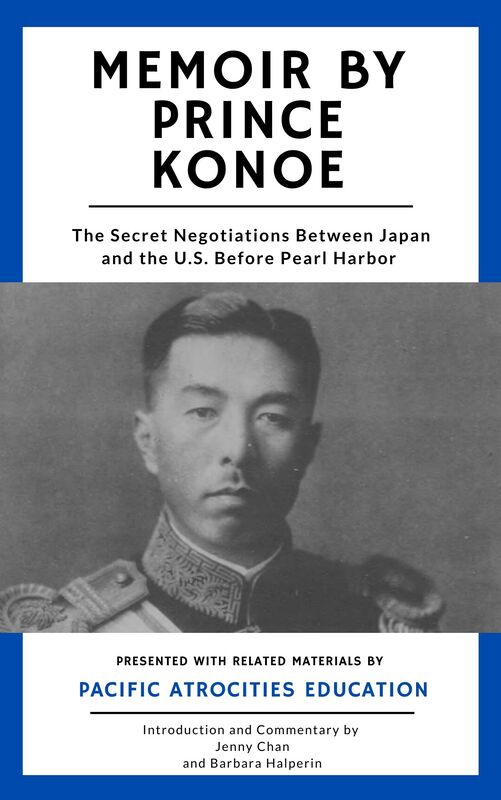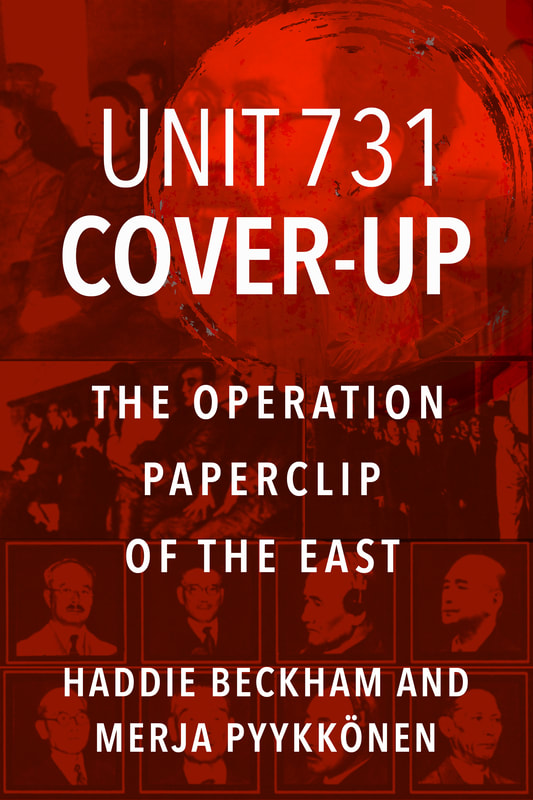|
by Jenna Marcus Overview Shigenori Togo was Japan’s minister of foreign affairs at both the beginning and end of the Japanese-Allied conflict during World War II.[1] Opposed to war, Togo, in 1941, unsuccessfully tried to arrange face-to-face negotiations between US President Franklin Delano Roosevelt and Japanese Prime Minister Fumimaro Konoe to prevent the outbreak of armed conflict.[2] His efforts, however, were ultimately unsuccessful. Togo resigned in 1942 but was asked to again become foreign minister in 1945. During this time, Togo was a strong advocate for the Japanese surrender, though his efforts again failed.[3] Who was Shigenori Togo? Togo was born in Kagoshima in 1882. After graduating from the Imperial University of Tokyo in 1904, he studied German at Meiji University. In 1912 he joined Japan’s Ministry of Foreign Affairs, where he served as a diplomat. Prior to the war, Togo worked in China, Europe, and the US, including as an ambassador to Germany and the Soviet Union. Togo was appointed the role of minister of foreign affairs in 1941, before the outbreak of the war.[4] Togo’s Unsuccessful Diplomatic Efforts In 1941, amidst high tensions between Japan and the US, the two countries attempted diplomatic negotiations to avoid war. Togo was opposed to armed conflict, believing that Japan could not win a war against the United States.[5] Despite months of diplomatic talks, however, neither side would budge on concessions. Notably, one of America’s most key demands — that Japan withdraw from China — was seen as unacceptable by Japanese military leaders. As negotiations failed to progress, Japan attacked Pearl Harbor on December 7, 1941. The following day the US declared war on Japan.[6] In 1942, Togo resigned as foreign minister due to disagreement over the conduct of the war and the method of political decision-making.[7] As a private citizen, Togo was an advocate for the Japanese surrender. “Considering the fact that [the war] was developing against Japan’s favor, I at any rate felt, especially after the loss of Saipan, that it was most difficult to carry on and that a war which offered no prospects should be terminated as soon as possible,” he wrote in an unpublished memoir.[8] As war prospects dwindled, Togo was again asked to become foreign minister in April 1945.9 Upon resuming his post, his main objectives were to prevent the Soviet Union from entering the war against Japan and to secure the Soviet Union as a mediator in discussions to terminate the war.[10] He favored a speedy and peaceful end to the war and believed that Soviet mediation would end the war on more favorable terms to Japan, as the US and Britain favored unconditional surrender.[11] Togo’s diplomatic efforts to end the war in 1945 proved misguided. While he earnestly wanted the war to end and made real efforts to win Soviet mediation, Japan’s leadership was not seriously committed to ending the war. In fact, it would be discovered that Japan had no real intent to surrender, as members of the administration were holding out hope that Japan would win a counter-invasion battle and turn the tide of the war.[12] Japanese diplomatic and military intercepts obtained by the US confirmed American suspicions that Japan was nowhere near a peace effort and that the Moscow Initiative was an attempt to avert defeat by taking advantage of American war weariness. After the war, key Japanese officials admitted they never agreed on concessions to obtain Soviet mediation, much less peace terms. Thus, Togo’s diplomatic efforts were doomed to fail.[13] The failure of Togo’s 1945 diplomatic efforts helped to solidify that the war would not have a peaceful end. After the war, Togo was sentenced to twenty years of imprisonment as a class-A war criminal. He died in prison in 1950 of illness.[14] Notes 1. “Foreign Minister Shigenori Togo,” Harry S. Truman Presidential Library and Museum, accessed June 5, 2023, https://www.trumanlibrary.gov/photograph-records/2017-3277. 2. Shigenori Togo, “Unpublished Memoirs of Foreign Minister Togo Shigenori,” April-August 1945, RG 544, Box 81, National Archives and Records Administration at College Park, College Park, Maryland. 3. Ibid. 4. “TOGO Shigenori,” National Diet Library Japan, accessed June 5, 2023, https://www.ndl.go.jp/portrait/e/datas/294/. 5. Togo, “Unpublished Memoirs of Foreign Minister Togo Shigenori.” 6. “Japan, China, the United States and the Road to Pearl Harbor, 1937–41,” Office of the Historian, accessed June 5, 2023, https://history.state.gov/milestones/1937-1945/pearl-harbor. 7. Togo, “Unpublished Memoirs of Foreign Minister Togo Shigenori.” 8. Ibid. 9. Ibid. 10. Ibid. 11. Ibid. 12. Richard B. Frank, “‘Pretty Little Phrases’: Japanese Diplomacy in 1945,” The National WWll Museum, August 14, 2020, https://www.nationalww2museum.org/war/articles/japanese-diplomacy-1945. 13. Ibid. 14. “TOGO Shigenori,” National Diet Library Japan, accessed June 5, 2023, https://www.ndl.go.jp/portrait/e/datas/294/ Read more
0 Comments
Leave a Reply. |
- Home
- Stories
-
Internship
- Summer 2024 Internship
- Summer 2023 Internship
- Fall 2022 Internship
- Summer 2022 Internship
- Summer 2021 Internship
- Fall 2020- Spring 2021 Internship
- Summer 2020 Internship
- Fall 2019 Internship
- Summer 2019 Internship >
- School Year 2018-2019 Internship
- Summer 2018 Internship >
- Fall 2017 Internship
- Summer 2017 Internship >
- Books
- Archives
-
Resource Page
-
Supplementary Research Guides
>
- Unit 731 - Guide >
-
Philippines' Resistance - Guide
>
- Philippines World War II Timeline
- The Japanese Invasion & Conquest of the Philippines
- Bataan Death March
- Formation of Underground Philippines Resistance
- Supplies of the Guerrilla Fighters
- The Hukbalahap
- Hunter's ROTC
- Marking's Guerrillas
- United States Army Forces in the Philippines of Northern Luzon (USAFIP-NL)
- The Aetas
- Chinese and Filipino-Chinese Nationalist Guerrilla Units
- The Female Faces of the Philippine Guerrillas
- Rising Sun Flag - Guide >
- Pinay Guerrilleras - Guide >
- Fall of Singapore - Guide >
- Three Years and Eight Months - Guide >
- Siamese Sovereignty - Guide >
- The Khabarovsk War Crimes Trial - Guide >
- Unit 731 Cover-up : The Operation Paperclip of the East - Guide >
- Marutas of Unit 731 - Guide >
- Prince Konoe Memoir - Guide >
- Competing Empires in Burma - Guide >
- Battle of Shanghai - Guide >
- Ishi Shiro - Guide >
- Taiwan The Israel of the East - Guide >
- Seeking Justice for Biological Warfare Victims of Unit 731 - Guide >
- Rice and Revolution - Guide >
- Clash of Empires - Guide >
-
Hunger for Power and Self-SufficiencyI - Guide
>
- The Influence of War Rations on Post-War Culinary Transformations
- How World War II Complicated Food Scarcity and Invention
- American Military Innovations
- Government-Sponsored Food Inventions in Europe during World War II
- Feeding the Army: The Adaptation of Japanese Military Cuisine and Its Impact on the Philippines
- Mixed Dishes: Culinary Innovations Driven by Necessity and Food Scarcity
-
Denial A Quick Look of History of Comfort Women and Present Days’ Complication - Guide
>
- The Comfort Women System and the Fight for Recognition
- The Role of Activism and International Pressure
- The Controversy over Japanese History Textbooks
- The Sonyŏsang Statue and the Symbolism of Public Memorials
- Activism and Support from Japanese Citizens
- The Future of Comfort Women Memorials and Education
- Echoes of Empire: The Power of Japanese Propaganda - Guide >
- Lesson Plans >
-
Supplementary Research Guides
>
|
Pacific Atrocities Education
730 Commercial Street San Francisco, CA 94108 415-988-9889 |
Copyright © 2021 Pacific Atrocities Education.
We are a registered 501 (c)(3) charity. |
- Home
- Stories
-
Internship
- Summer 2024 Internship
- Summer 2023 Internship
- Fall 2022 Internship
- Summer 2022 Internship
- Summer 2021 Internship
- Fall 2020- Spring 2021 Internship
- Summer 2020 Internship
- Fall 2019 Internship
- Summer 2019 Internship >
- School Year 2018-2019 Internship
- Summer 2018 Internship >
- Fall 2017 Internship
- Summer 2017 Internship >
- Books
- Archives
-
Resource Page
-
Supplementary Research Guides
>
- Unit 731 - Guide >
-
Philippines' Resistance - Guide
>
- Philippines World War II Timeline
- The Japanese Invasion & Conquest of the Philippines
- Bataan Death March
- Formation of Underground Philippines Resistance
- Supplies of the Guerrilla Fighters
- The Hukbalahap
- Hunter's ROTC
- Marking's Guerrillas
- United States Army Forces in the Philippines of Northern Luzon (USAFIP-NL)
- The Aetas
- Chinese and Filipino-Chinese Nationalist Guerrilla Units
- The Female Faces of the Philippine Guerrillas
- Rising Sun Flag - Guide >
- Pinay Guerrilleras - Guide >
- Fall of Singapore - Guide >
- Three Years and Eight Months - Guide >
- Siamese Sovereignty - Guide >
- The Khabarovsk War Crimes Trial - Guide >
- Unit 731 Cover-up : The Operation Paperclip of the East - Guide >
- Marutas of Unit 731 - Guide >
- Prince Konoe Memoir - Guide >
- Competing Empires in Burma - Guide >
- Battle of Shanghai - Guide >
- Ishi Shiro - Guide >
- Taiwan The Israel of the East - Guide >
- Seeking Justice for Biological Warfare Victims of Unit 731 - Guide >
- Rice and Revolution - Guide >
- Clash of Empires - Guide >
-
Hunger for Power and Self-SufficiencyI - Guide
>
- The Influence of War Rations on Post-War Culinary Transformations
- How World War II Complicated Food Scarcity and Invention
- American Military Innovations
- Government-Sponsored Food Inventions in Europe during World War II
- Feeding the Army: The Adaptation of Japanese Military Cuisine and Its Impact on the Philippines
- Mixed Dishes: Culinary Innovations Driven by Necessity and Food Scarcity
-
Denial A Quick Look of History of Comfort Women and Present Days’ Complication - Guide
>
- The Comfort Women System and the Fight for Recognition
- The Role of Activism and International Pressure
- The Controversy over Japanese History Textbooks
- The Sonyŏsang Statue and the Symbolism of Public Memorials
- Activism and Support from Japanese Citizens
- The Future of Comfort Women Memorials and Education
- Echoes of Empire: The Power of Japanese Propaganda - Guide >
- Lesson Plans >
-
Supplementary Research Guides
>


